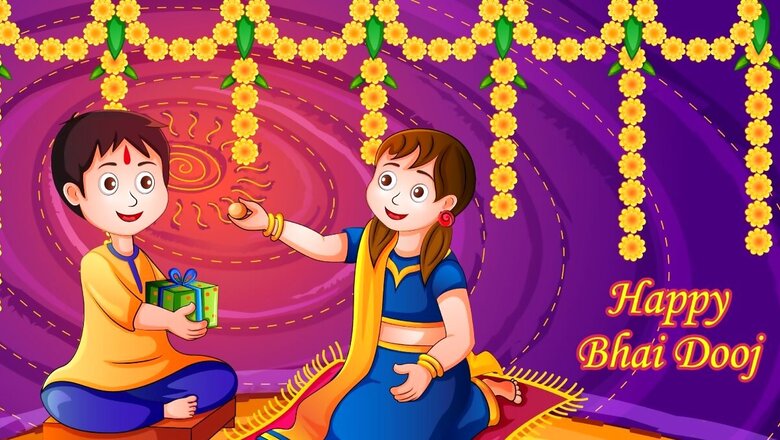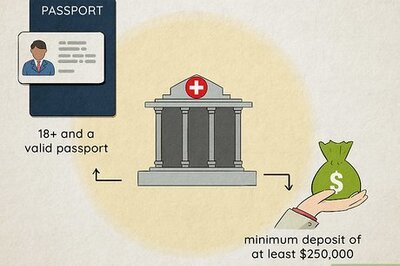
views
Bhai Dooj, a significant Hindu festival, celebrates the bond between brothers and sisters. It falls on the second day of the Hindu calendar’s Dwitiya Tithi. Also known as Bhratri Dwitiya, it is observed twice in the Hindu calendar. The more popular Bhai Dooj is celebrated two days after Deepavali Puja.
Holi Bhai Dooj, although less known, is observed on Dwitiya Tithi and may fall either the day after Holika Dahan or the second day after Rangawali Holi. According to Drikpanchang, Holi Bhai Dooj will be celebrated on March 27 this year.
Bhai Dooj is celebrated across the nation, following the legend of Lord Yama and Yamuna. It is also known as Yama Dwitiya in some regions. The festival is not only about the bond between brothers and sisters but also about celebrating the relationship and affection between siblings. It is a day for siblings to strengthen their bond and renew their commitment to each other.
Holi Bhai Dooj 2024: Date And Timings
- Date: This year, Holi Bhai Dooj falls on Wednesday, March 27, 2024.
- Dwitiya Tithi Begins :02:55 PM on March 26, 2024
- Dwitiya Tithi Ends:05:06 PM on March 27, 2024
Historical Background And Origin Of Holi Bhai Dooj
Bhai Dooj, like Raksha Bandhan, celebrates the relationship between siblings. According to Hindu mythology, there are several legends surrounding Bhratri Dwitiya. One legend tells of Lord Yama, the god of death, visiting his sister Yamuna (the river) on Dwitiya of the Shukla Paksha in Kartik month.
Yamuna applied sandalwood paste or tilak on Lord Yama and offered him delicacies. Lord Yama then declared that any sister who applies tika and feeds her brother on this date will be blessed with longevity and prosperity.
Holi Bhai Dooj Symbolism And Significance
Bhai Dooj reminds us of the importance of family and the bonds that unite them. It reminds us to cherish the love and affection we share with our siblings, to honour and respect each other, and to forgive past differences, starting anew with love and affection.
The celebration of Bhai Dooj varies regionally but typically includes rituals like applying tika (a mark on the forehead), performing aarti (a ritual of worship), exchanging gifts, and sharing a meal together. Sisters pray for the long and prosperous life of their brothers, and brothers promise to protect and support their sisters.
The festival also holds cultural significance, highlighting the values of love, respect, and togetherness within families. It is a time when family members come together, strengthening their bonds and creating lasting memories.
Bhai Dooj is a time to cherish and appreciate the love and affection we share with our siblings and to reaffirm our commitment to each other.
Rituals And Customs Of Holi Bhai Dooj
- The day often begins with a cleansing bath for both the brother and sister.
- Sisters will prepare a puja thali, a special plate containing various offerings.
- This typically includes a diya (earthen oil lamp), roli (vermilion powder), chawal (rice), fruits, sweets, betel nut, and moli (sacred thread).
- The centerpiece of the celebration is the tilak ceremony. The sister applies a tilak, a paste or mark, on the brother’s forehead. This is usually made with roli and sometimes other materials like sandalwood paste.
- While applying the tilak, the sister chants mantras, or prayers, for her brother’s well-being and long life.
- An aarti is then performed, which involves circling the puja thali with the lit diya in front of the brother.
- After the tilak ceremony, the sister offers her brother sweets and other treats.
- The festival is also a time for gift giving. Sisters traditionally gift their brothers something special, and brothers may return the gesture with gifts for their sisters.
- Some variations in rituals exist depending on the region. In Maharashtra, Gujarat, Goa, and Karnataka, the festival is known as Bhau Beej. Here, sisters might draw a square on the floor for the brother to sit in while the puja is performed.
- In some places, sisters might also perform aarti for the moon god Chandra if they don’t have a brother.




















Comments
0 comment